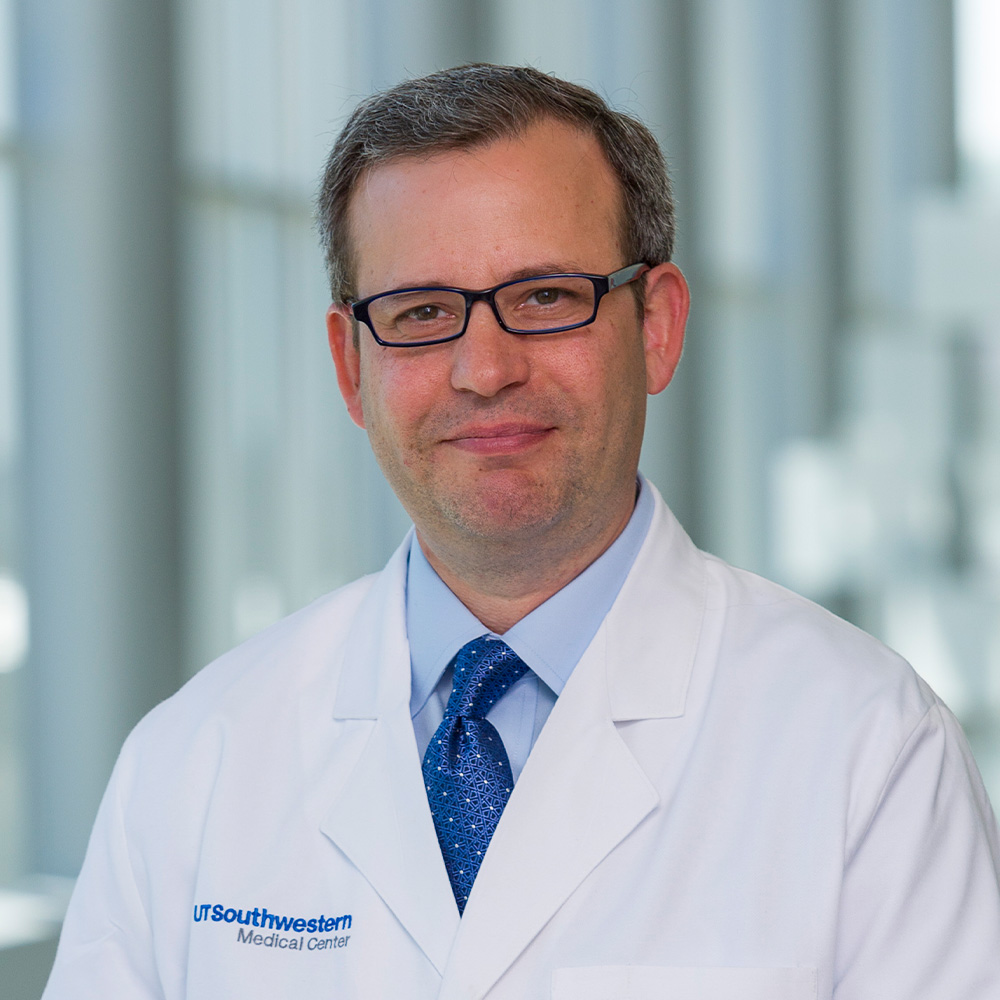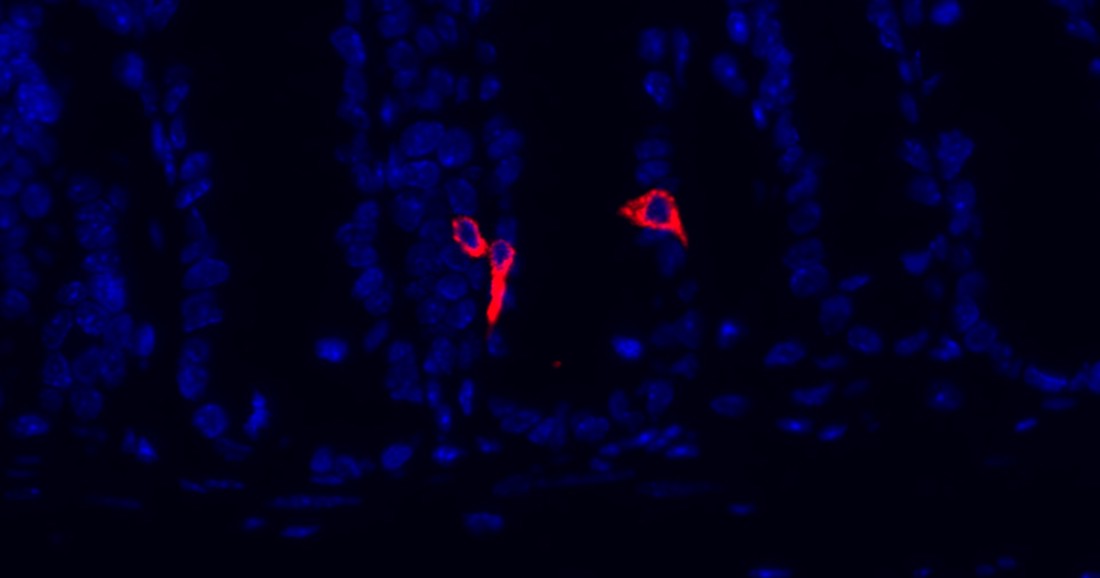Research could lead to treatments for obesity, extreme weight loss
Interplay of intestinal bacteria, host cells affects body weight, UTSW researchers find
DALLAS – June 13, 2024 – Mysterious cells that secrete hormones in the large intestine play a key role in regulating body weight through their relationship with intestinal bacteria, a study led by UT Southwestern Medical Center researchers suggests. Their findings, published in Nature Metabolism, could lead to new treatments for obesity and extreme weight loss.

“This work provides a new understanding of the complex metabolic interplay between bacteria and the host, shedding light on novel mechanisms that control appetite and body weight,” said Ezra Burstein, M.D., Ph.D., Professor of Internal Medicine and Chief of the Division of Digestive and Liver Diseases at UT Southwestern. Dr. Burstein co-led the study with UTSW colleagues Luis Sifuentes-Dominguez, M.D., Assistant Professor of Pediatrics, and Shuai Tan, Ph.D., Research Scientist.
For about a century, scientists have known that the lining of the intestines contains hormone-producing cells known as enteroendocrine cells (EECs). In the small intestine, EECs sense nutrients passing through the organ and secrete hormones that control digestion and absorption. However, since the large intestine is thought to mostly absorb water and salt, the role of EECs there has been unclear.
To investigate, the UTSW researchers used a targeted genetic technique to prevent this type of cell from developing in the large intestine, also known as the colon, of lab mice. As these animals grew into adulthood, they gradually became obese from overeating and developed changes that accompany obesity, including poor blood sugar control. Tests showed these mice had elevated amounts of glutamate in their stool. Other experiments showed that this amino acid influences appetite in the brain, an effect not previously known.

Surprisingly, the extra glutamate stemmed not from intestines without EECs but from intestinal bacteria, whose composition became different in the genetically altered mice compared with unaltered littermates. Supplementing unaltered mice with glutamate increased their appetites similarly to animals in which EECs in the colon had been deleted.
Together, Dr. Burstein said, these findings suggest that interplay between colonic EECs and intestinal bacteria regulates the intestinal flora’s composition, affecting how much glutamate these microbes secrete – and, in turn, influencing the host animal’s appetite. Eventually, researchers may be able to create treatments for obesity based on these findings by decreasing intestinal glutamate or for extreme weight loss disorders such as anorexia nervosa by increasing this amino acid.
In the meantime, Dr. Burstein and his colleagues are investigating several questions, including how EECs communicate with intestinal bacteria and how glutamate produced in the intestines sends a signal to the appetite-regulating center in the brain.
Other UTSW researchers who contributed to this study include Jacobo Santolaya, M.D., Assistant Professor of Pediatrics; Teppei Fujikawa, Ph.D., Assistant Professor of Internal Medicine; Goncalo Vale, Ph.D., Assistant Professor in the Center for Human Nutrition and of Molecular Genetics; Jeffrey McDonald, Ph.D., Professor in the Center for Human Nutrition and of Molecular Genetics; Hamid Baniasadi, Ph.D., Assistant Professor of Biochemistry; Xiaowei Zhan, Ph.D., Assistant Professor in the Peter O’Donnell Jr. School of Public Health and the Center for the Genetics of Host Defense; Yuuki Obata, Ph.D., Assistant Professor of Immunology and Neuroscience; Joel Elmquist, D.V.M., Ph.D., Professor of Internal Medicine, Pharmacology, and Psychiatry and Vice Chair of Research for Internal Medicine; Tiffany Freeney Wright, M.D., clinical fellow in Pediatric Gastroenterology; Qi Liu, Ph.D., postdoctoral fellow; Adam Lopez, Ph.D., Lab Coordinator; Andrew Schmidt, B.S., Research Technician; and Jiwoong Kim, M.S., Computational Biologist.
Dr. Burstein holds the Berta M. and Dr. Cecil O. Patterson Chair in Gastroenterology. Dr. Obata is a Nancy Cain and Jeffrey A. Marcus Scholar in Medical Research, in Honor of Dr. Bill S. Vowell. Dr. Elmquist holds the Carl H. Westcott Distinguished Chair in Medical Research and the Maclin Family Distinguished Professorship in Medical Science, in Honor of Dr. Roy A. Brinkley. Dr. Burstein and Dr. Zhan are also members of the Harold C. Simmons Comprehensive Cancer Center.
This study was funded by grants from the National Institutes of Health (P30DK127984, R01DK070855, R01DK130957, R01DK107733, K08DK127197, T32DK007745, UL1TR003163, P01HL160487, P01DK119130, R01DK127274, R01DK100659, R01HG011035, and U01AI169298); the Howard Hughes Medical Institute; the Pollock Family Center for Research in Inflammatory Bowel Disease; the MMK Foundation; the Nancy Cain and Jeffrey A. Marcus Scholar in Medical Research, in Honor of Dr. Bill S. Vowell; the Pew Scholars Program in Biomedical Sciences; the Scientific and Technological Research Program of Chongqing Municipal Education Commission (KJQN2021043); Natural Science Foundation of Chongqing (CSTB2022NSCQ-MSX1027); the National Science Fund for Distinguished Young Scholars (32125012); and the Natural Science Foundation of China (92254302).
About UT Southwestern Medical Center
UT Southwestern, one of the nation’s premier academic medical centers, integrates pioneering biomedical research with exceptional clinical care and education. The institution’s faculty members have received six Nobel Prizes and include 25 members of the National Academy of Sciences, 21 members of the National Academy of Medicine, and 13 Howard Hughes Medical Institute Investigators. The full-time faculty of more than 3,100 is responsible for groundbreaking medical advances and is committed to translating science-driven research quickly to new clinical treatments. UT Southwestern physicians provide care in more than 80 specialties to more than 120,000 hospitalized patients, more than 360,000 emergency room cases, and oversee nearly 5 million outpatient visits a year.
